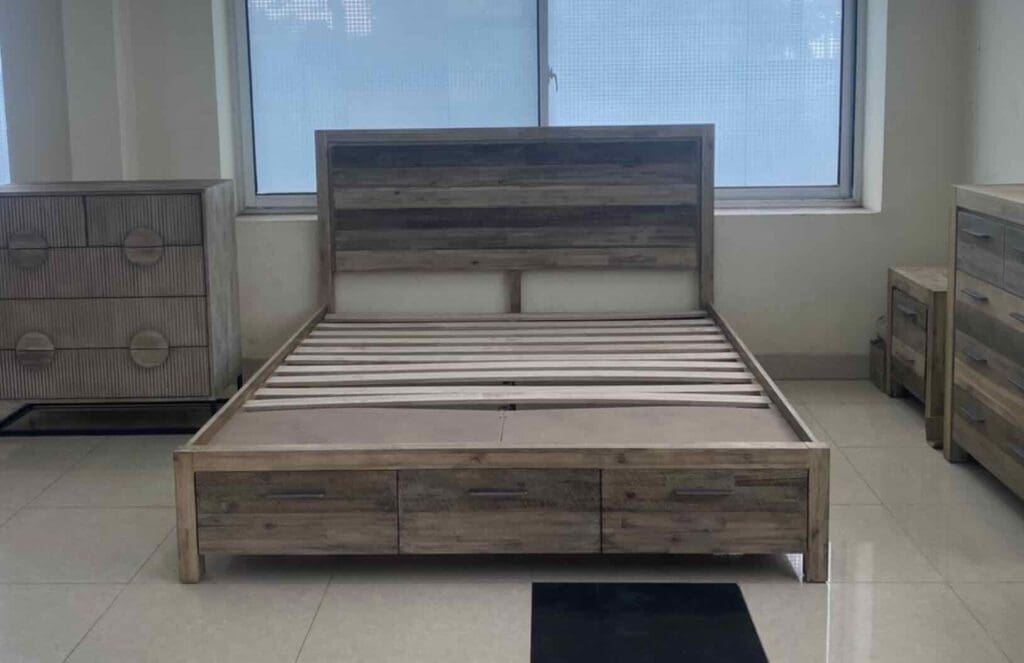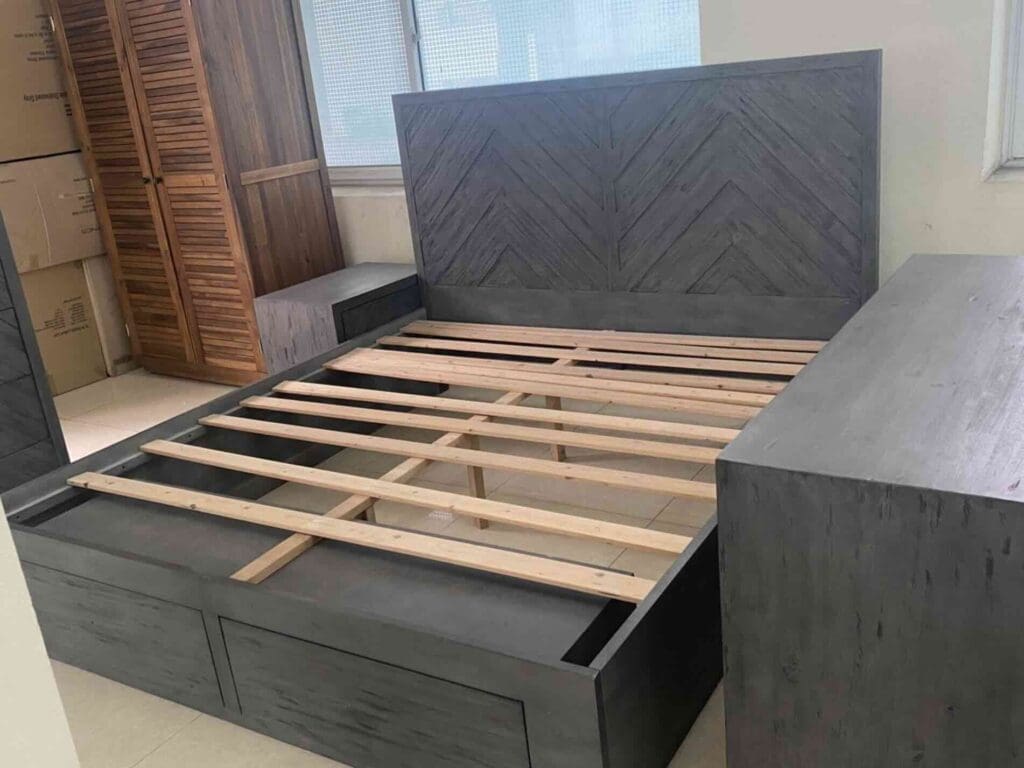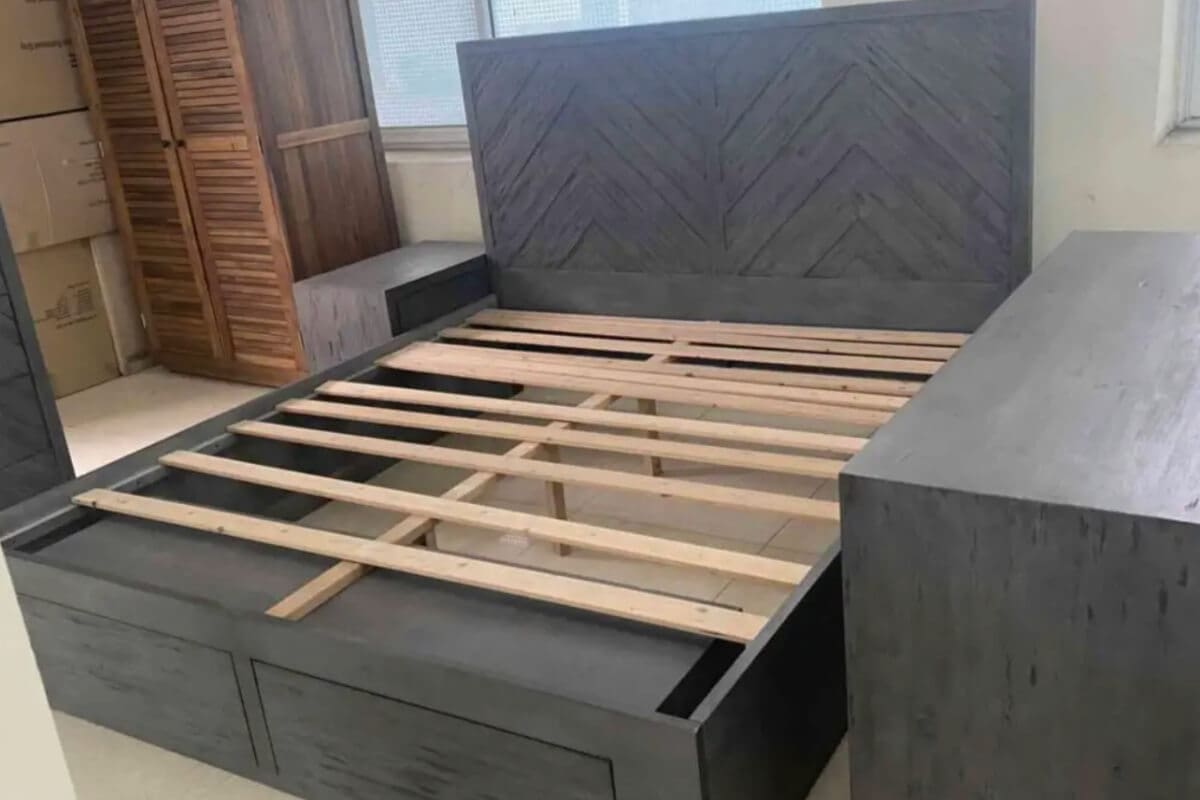Creating a tranquil and comforting sleep sanctuary starts with choosing your bed frame’s proper foundation. Solid wood bed frames offer an unparalleled blend of durability, aesthetic versatility, and the warmth of natural materials, making them a prime choice for any family home.
With an emphasis on eco-conscious living, the choice of a solid bed frame promises a healthier indoor and outdoor environment. As we embark on this journey through the forest of options, from the stately oak to the rustic pine, we’ll consider the many benefits of integrating solid wood into our bedrooms, how to discern which type and style best fit our lives, and the vital importance of sustainability in our decisions.
Table of Contents
- Benefits of Solid Wood Bed Frames
- Selecting the Right Type of Wood and Style
- Safety and Size Considerations for Family Beds
- Related Content
Benefits of Solid Wood Bed Frames
Why a Solid Wood Bed Frame Is the Heart of a Cozy Family Haven
When crafting the perfect family haven, every choice speaks volumes about comfort, durability, and warmth. It’s not just about picking out furniture; it’s about creating a sanctuary where memories are made and dreams are gently nurtured. That’s why choosing a solid wood bed frame can be one of the family’s most important decisions in defining their space.
Solid wood bed frames are tomorrow’s heirloom pieces, offering unmatched durability and timeless style. Solid wood frames are built to last, unlike their metal or composite counterparts, often becoming sturdier with age.
This investment can withstand the pitter-patter of little feet clambering up for a bedtime story and the occasional jump of excitement on a lazy Sunday morning.
But let’s talk about safety, a priority for any family-focused home. Solid wood frames are a fantastic option for cultivating a toxin-free environment. They typically contain fewer chemicals and synthetic materials than other types of furniture, making them a healthier choice for everyone, especially for children with allergies or sensitivities.
The versatility of a solid wood bed frame is undeniable. Whether it’s a sleek, modern design for an upscale city loft or a rustic, hand-carved piece for a country-style retreat, wood frames complement any décor. And with the potential to refinish and update the look over the years, these bed frames adapt to changing tastes and styles – growing just as the family does.
Let’s also think of comfort – the softer, warmer touch of wood provides a coziness that metal frames can’t match. Wood has insulating properties, keeping the bed warmer in the winter and cooler in the summer, ensuring sweet dreams year-round.
Moreover, the earthy tones and natural textures of wood add an element of grounding and tranquility to a bedroom. It’s an organic reminder to slow down, breathe, and enjoy life’s simplicity amidst the chaos of daily schedules and digitized interactions. The nurturing presence of a solid wood bed frame can transform a room into a restful retreat.
And don’t underestimate the power of aesthetics. A gorgeous solid wood frame also acts as a focal point, offering character and telling its own story through the grains and knots of its unique pattern. It’s a conversation starter, a piece of art, and a testament to individual style, all in one sturdy package.
Ultimately, opting for a solid wood bed frame boils down to investing in quality, comfort, and character for a family haven. It’s about creating a space as reliable and steadfast as the family it cradles, ensuring a legacy of well-rested nights and cherished memories beautifully framed in wood’s natural splendor.

Selecting the Right Type of Wood and Style
When scouting for the perfect wood and style for a cherished home, one has to consider not just the visual impact but also how it aligns with the functional needs of a family. Wood is not just a material – it’s a statement of warmth, durability, and sustainability. Now, let’s dive into the nuances of selecting the right type and style of wood to enhance the home environment.
Understanding the nuances of different woods is critical. Hardwoods like oak, maple, and walnut are known for sturdiness and are often selected for areas frequented by the pitter-patter of little feet.
These woods can withstand the test of time and the energetic activities of young ones, making them ideal choices for communal spaces such as living rooms or dining areas. Conversely, softer woods like pine offer a cost-effective alternative, bringing a cozy feel to spaces with less hustle and bustle.
Next, consider the finish and grain of the wood. Lighter finishes can make a room feel more open and airy – perfect for creating an inviting atmosphere in small or dimly lit rooms. Darker finishes, meanwhile, offer a touch of sophistication and can anchor a space with a sense of permanence. The grain of the wood also plays into the aesthetic; the unique patterns can either be flaunted for a rustic, earthy vibe or minimized for a sleek, contemporary look.
When it comes to style choices, always bear in mind the home’s architectural elements. A craftsman-style home, for instance, resonates with the natural beauty of quarter-sawn oak that complements its rich woodwork. On the contrary, a modern minimalist abode might benefit from the clean lines offered by a maple or birch.
Wood integration into a home extends beyond furniture; consider built-ins, trim work, or accent walls. These elements are not just functional – they’re an expression of personality and style that adds layers of texture and depth to the storytelling of a home.
Lastly, consider the broader impact of the choice of wood. In today’s era, sustainability is more than a buzzword – it’s a responsibility. Opting for locally sourced, sustainably harvested wood or reclaimed wood products supports the environment and brings an untold story and a sense of history into the family abode.
Choosing the suitable wood and style for a home is a harmonious blend of practicality, aesthetic appeal, and environmental conscientiousness. It’s about creating a safe, welcoming, and sustainable environment that grows and adapts alongside the family it houses. Considering these considerations, anyone can lay the foundation for a home filled with warmth, character, and love.

Safety and Size Considerations for Family Beds
When it comes to curating a safe and nurturing home environment, particularly in the bedrooms where your family rests and rejuvenates, prioritizing safety and size in selecting wood furnishings is paramount. Let’s dive into the considerations that ensure you make the best choices for your cherished home spaces.
Safety first! When selecting furniture, especially for children’s rooms, one must ensure the edges are rounded to prevent unnecessary bumps or bruises. Look for bed frames with smooth finishes free of splinters or rough patches that could snag pajamas or skin.
Stability is another significant aspect — a bed should not wobble or tip easily, as this poses a risk, especially with active little ones who see their bed as a potential fort or pirate ship.
In size, it’s not just about fitting a bed into a room but considering the room’s flow. Is there ample space to walk around the bed without tripping? Can drawers and closet doors open fully without being hindered? Also, consider future growth — a toddler’s single bed might be snug and sweet now, but will it still be functional a few years later? Opting for a larger bed could be a wiser investment.
Then, reflect on the different types of wood and their inherent qualities. Hardwoods like oak and maple are renowned for their durability and can withstand the energetic play of kiddos. At the same time, softwoods such as pine offer a softer aesthetic at the potential cost of nicks and scratches. It balances resilience and the warmth of the wood’s character.
The finish and grain of the wood are not just about visual appeal; they also contribute to the longevity and maintenance of the furniture. A high-gloss finish might show fingerprints and dust more quickly, whereas a matte finish might be more forgiving. The wood grain can also hide or highlight wear and tear, so choose according to the room’s activity level.
In homes with distinct architectural elements, selecting wood styles that either complement or tastefully contrast can add to the charm. A modern home might embrace clean lines and minimalist wood furniture, while ornate wood detailing could enhance a traditional setting.
For those who love to infuse their space with a touch of nature, integrating wood beyond bed frames — think bookshelves, accent walls, and even wooden beams — can add a sense of coherence and earthiness to a room. However, balance is critical. Too much wood can overwhelm you; find a harmony that feels right.
The environmental impact and sustainability of wood should not be overlooked. With certifications like the Forest Stewardship Council (FSC), wood sourced from responsibly managed forests ensures that harmful chemicals do not compromise your family’s health. Likewise, it supports a more significant commitment to the planet that future generations will inherit.
Ultimately, creating a safe, welcoming, and sustainable home environment with wood involves mindful selections that contribute to your family’s well-being and comfort. Bearing in mind safety, appropriateness of size, the nature of different woods, and the sustainability of your choices, every decision becomes an extension of your care and love for your family’s home.

A solid wood bed frame is more than a piece of furniture; it’s a testament to timeless craftsmanship, a healthy lifestyle, and a commitment to the environment.
As we’ve traveled through the various aspects from selection to maintenance, it’s clear that such a bed frame is not just the backbone of restful nights but also a central pillar of a thoughtful, family-oriented home.
With the correct information and a discerning eye, your investment in a solid wood bed frame will stand the test of time, bringing beauty, stability, and peace of mind to your domestic haven.
If you want to see how Mondoro can help you export and manufacture high-quality solid wood furniture, we would love to talk to you.
At Mondoro, we would love to help you decide which material would be best for manufacturing your home decor and furniture product.
Find out more about how Mondoro can help you create, develop, and manufacture excellent home decor and home furniture products – including lacquer furniture. Don’t hesitate to contact me, Anita. Check out my email by clicking here or become a part of our community and join our newsletter by clicking here.
Mondoro gives out a FREE Lookbook to anyone interested. You can receive a copy of our latest Lookbook by clicking here.
Listen to our Podcast called Global Trade Gal. You can find it on all major podcast platforms. Try out listening to one of our podcasts by clicking here.
Subscribe to our Mondoro Company Limited YouTube Channel filled with great videos and information by clicking here.
Related Content
10 Types of Grain Patterns of Solid Wood Furniture Explored
We will explore ten different types of grain patterns found in solid wood furniture, including Maple, Beech, Hickory, Oak, Teak, Pine, Rubberwood, Walnut, Douglas Fir, and Spruce. We will delve into the characteristics of each wood type and examine how their distinct grain patterns contribute to their suitability for furniture production.
You can discover more by reading 10 Types of Grain Patterns of Solid Wood Furniture Explored by clicking here.
Is Solid Wood Furniture Expensive? 3 Factors To Consider
Three main factors can significantly influence the furniture price if you choose solid wood. These factors include the type of wood used, the size of the furniture piece, and the construction techniques employed, all of which play a crucial role in determining the final cost. Read on as we explore each of these.
You can learn more by reading Is Solid Wood Furniture Expensive? 3 Factors To Consider by clicking here.
Why Is It So Hard To Find Solid Wood Furniture Manufacturers?
Locating trustworthy solid wood furniture manufacturers can be an intricate endeavor for retailers and wholesalers. The task’s complexity is rooted in many factors related to solid wood furniture’s production and manufacturing procedures. Read on as we explore the complex task of the search for solid wood furniture manufacturers and how Mondoro can help you.
You can learn more by reading our blog Why Is It So Hard To Find Solid Wood Furniture Manufacturers? by clicking here.

